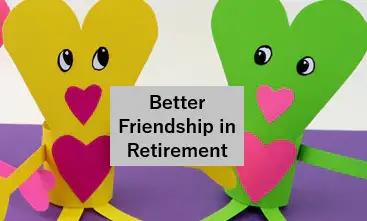How to have better friends in retirement
Understanding your attachment style can help you have better friendships in retirement.
About half have a secure attachment style. The rest have a mix of insecure attachment features (like avoidant or anxious). The good news is that attachment styles are stable but malleable over time. You can and should improve your knowledge of how attachment styles affect friendships.
Do you have room to improve your friendships? Take this brief attachment quiz and see how you score.
Better Friendship in Retirement
So, how did you do?
I did poorly. About 50% of people have secure attachment styles.
Beyond that, about 25% have avoidant, and 25% have anxious attachment styles. That’s not quite true, as there are us lucky folk with mixed avoidant/anxious styles. But it is close enough to dig into the two major insecure attachment styles.
Avoidant Attachment Style
The avoidance attachment style is related to the right or left shift in the frontal cortex. Do you approach (vs. avoid) interpersonal relationships? Approach is thought to be a right shift in cortex activity.
Avoidants use deactivation strategies if the relationship is stressed, which usually results in distancing. Occasional hyperactivation strategies (clinging, coercive, or even manipulative) are used.
The avoidant style describes folks who withdraw from relationships when stressed, though their inner dialogue and fears are frequently unfounded.
A word salad description of the avoidant attachment style might include:
Over (or under) confident, delayed intimacy, focus on minor flaws, remembering past stressors, hypervigilant, flirting, ignoring, secrets. Can’t take closeness or intimacy for granted. Feel suffocated when too close. Negotiate for space and independence. Dismissive attitude towards closeness.
Interestingly, the avoidant folks have the same cortisol spike with drama/stress, but they cover up their symptoms. With significant enough stress, they tend to devolve into anxious tendencies.
Anxious Attachment Style
Anxious attachment, sometimes called ambivalent, occurs when you worry that your friends will abandon you even if there is no reason to think so. Insecure bonding happens during infancy.
Here is a word salad description of Anxious Attachment:
Worried, overthink, take things personally, micromanage, project negative outcomes, mind games, manipulation, acting out, jealous, quickly bonds, idealizing, needs suppression. Craves intimacy but sensitive to smallest of threats.
Those with anxious attachment styles have the most to gain from a study of secure relationships as they can improve.
How Attachment Styles Work in Retirement
Although attachment style is set in childhood, it also affects your relationships in retirement. Belonging is important throughout your life but becomes a focal point of socialization in retirement.
Loneliness is common, so focusing on better relationships is important.
Understanding your attachment style is the key to shunting drama and cortisol responses in exchange for emotionally mature, secure attachment interactions.
Data show that a secure attachment style promotes improved well-being and happiness in seniors. Improved attachments improve quality of life. Also, those with secure attachment styles had younger friends on average.
Finally, it is interesting for women to note that about 75% of mothers cite their daughters as one of the most important contacts in their lives, which is predictive of retirement happiness. So, mothers, don’t let your daughters grow up to be cowboys.
Improve Friendships in Retirement
Understand your attachment style and improve friendship in retirement. Work on self-acceptance and self-love. These are the gifts you give yourself that allow you to express love to others and, thus, be loved by others.
Have strong boundaries for toxic people and people who criticize you or drain your energy. Exclude 20% of people from your life.
Feel and express emotions.

Learn to identify, honor, and express emotional needs. While there are just 6-8 primary emotions, our interpretations of what we feel overwhelm our physical feelings. Men, especially, need to focus on feeling emotions. And while you are numbing (we all numb), you lose out on both the positive and the negative emotional experiences. Emotion wheels are an interesting place to start when you want to describe what you are feeling in your body.
Be vulnerable about your feelings (in the appropriate setting). Understand and focus on your needs, and be specific, assertive, and non-apologetic. Listen and don’t blame.
Summary: How to Improve Friendship in Retirement
In summary, to improve friendships in retirement, be true to yourself and do what you say you will do.
In other words, don’t be manipulative or overly self-centered. Instead, have empathy, confidence, and a strong self-identity and consider others in your decisions.
Honesty has no agenda. It does not have tactics or play games. Simple interactions are not misinterpreted or overthought.
If you feel like you are getting mixed messages, conflicting actions, or any push/pull or hot/cold from someone, or if your gut doesn’t feel right when interacting with someone but aren’t sure exactly why, take your time developing the relationship. Or find something else to do.
The idea is to understand what it takes to have a secure attachment and model and mirror it.
Think about what annoys you in other people. Then, understand that those are likely the issues you must work on the most. We tend to dislike in others what we need to work on ourselves.
